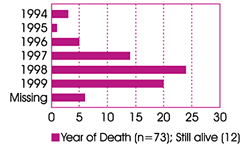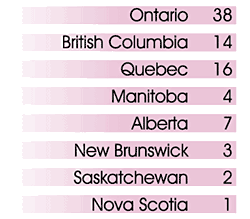Common menu bar links
Institutional links
Diseases & Conditions
Health & Safety
Research & Statistics
Agency Information
Search Box
E-mail this page
Creutzfeldt-Jakob Disease
Quick Links
CJD-Surveillance System
| Newsletters to Families | Newsletters to Physicians |
May 2000
CJD-SS Study Up-date
The CJD-Surveillance System (CJD-SS) was launched in April 1998 when an information package concerning our project was mailed out to all physicians whom we thought may be involved in the care of persons diagnosed with CJD. This included neurologists, neuropathologists, neurosurgeons, geriatricians and infectious disease specialists. As of 1 October 1999, we have had 85 referrals to the CJD-SS from physicians who encounter these cases in their practice (Figure 1). Of these 85 referrals we have had gene sequencing done on 30 and autopsies done on 55 cases. The majority of the cases have been reported from Ontario, British Columbia and Quebec (Figure 2); this representation is as expected as this reflects the provinces with the highest concentration of the Canadian population. Of these referrals we have had positive confirmation of CJD by pathology on 39 cases; the remaining cases were either not definitively confirmed by autopsy (11 cases), definitively diagnosed as other than CJD (four cases) or still awaiting confirmation (31 cases).
We have had three iatrogenic cases as well as three cases of Gerstmann-Sträussler-Scheinker Syndrome (GSSS) reported to the system. The iatrogenic cases have all been dura mater derived. No cases of vCJD have been identified in Canada.
Figure 1. CJD-SS Reports (n=85)  |
CJD now a reportable disease
CJD has become a disease under national surveillance, effective 1 January 2000. Generally speaking, this means that practicing physicians are required to report clinical diagnoses of CJD to the local public health authority, with or without laboratory confirmation. If it meets the surveillance case definition, the case will be reported to the provincial/territorial health authority which, in turn, reports it to the Laboratory Centre for Disease Control, Health Canada. The patient cannot be identified by name: only aggregate data are collected and published once a year in the Notifiable Diseases Annual Summary, a supplement to the Canada Communicable Disease Report. The published aggregate data include gender, age-group and province. Disease surveillance at the federal level focuses on populations rather than individual patients. Diseases are chosen for national surveillance after a rigorous review process where each disease/condition is assessed according to 10 criteria. Each disease is assigned a score and, consequently, all diseases are ranked from the highest score to the lowest. The case may be followed up with a more detailed questionnaire from the National Creutzfeldt-Jacob Surveillance Program.
Figure 2. Provinces Reporting CJD Cases  |
14-3-3 Protein Test
This is a highly sensitive and specific method for diagnosis of prion diseases.
The 14-3-3 protein test done on the cerebrospinal fluid (CSF) of patients with suspected CJD has recently been considered as an effective tool for a diagnostic test performed before death. The 14-3-3 protein has never been found in the CSF of normal controls and has been reported to be detectable in disorders with a rapid loss of nervous tissue. The 14-3-3 protein is also reported in the CSF of patients with other neurologic diseases including viral encephalitis, herpes simplex encephalitis (HSE), multi-infarct dementia, acute infarction, stroke within 1 month, subarachnoid hemorrhage, and Rett's syndrome. In sporadic CJD, the sensitivity of the 14-3-3 test is 84%-96%, and the specificity 88%-100% based on CJD surveillance studies from the USA, UK, France, and Germany. It is not understood why this protein is particularly found in CJD as opposed to the dementing illnesses. However, the sensitivity of the test is much lower in the vCJD than in the sporadic form and negative results can occur presumably in GSSS, a slowly progressing prion disease. In 1999, we set up a prion laboratory at the Centre for Research in Neurodegenerative Diseases (CRND) at the University of Toronto to perform the 14-3-3 test to screen out CJD and some familial prion diseases from suspected patients with dementia. So far we have tested 23 CSF samples from the suspected CJD patients and found seven positive cases.
